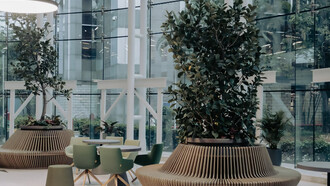In a phase of humanity where climate change looms large, the boutique hospitality industry is at a pivotal crossroads. The luxurious allure of boutique hotels is being gently stitched with the threads of sustainability, creating a new approach honoring opulence and the earth. From eco-friendly hygiene protocols and sustainable cutlery to smart lighting and solar-powered electricity, this shift is underlining the widespread adoption of environmentally conscious practices.
Right from the sun-soaked terraces of Mediterranean retreats to the lush rainforests of Southeast Asia and the beaches of Southern European countries, boutique hotels everywhere are tweaking their hospitality intentions. The idea now is to not only curate a memorable vacation but to uncover avenues that sew a grounding bond with the local environment, cultural ethos, and planetary health.
We’re seeing carbon footprint reductions through farm-to-table meals, energy-efficient washing and air conditioning systems, water-saving measures, motion sensors, renewable energy plans, and bans on single-use plastic. Carrying onto this trend, hotels are steadily reducing their collective 1% contribution to global carbon emissions1.
Long-term resilience and futureproofing began in 2013
The Brutalist Pirelli building went from being an aesthetically hideous structure12to amongst the USA’s most energy-efficient hotels. The jump from greenwashing to working towards net-zero hotels is supported by bodies like the New Building Institute, Sustainable Hospitality Alliance, and the UN World Tourism Organization.
Hats off to hotels like Svart3for aiming to become the globe’s foremost net-positive hotel. Just like they deploy solar panels on a mass scale and recycle heat generated at their onsite data center, other boutique hotels have used heat pumps, concrete as their main building materials, and power over ethernet (POE) systems that present low-voltage power.
Look at Fogo Island Inn4 in Canada. They’ve used geothermal heating and rainwater collection systems to support the model of sustainable hospitality. Similarly, Whitepod in Switzerland erects geodesic domes anchored on a wooden platform to avoid soil disturbance. Likewise, Soneva Fushi in the Maldives5has rolled out a desalination plant for fresh water and also the Slow Life “Sustainable local organic wellness learning inspiring fun experiences” philosophy to educate guests on sustainable living.
A rewarding matter of brand reputation
Formulating an across-the-board decarbonization plan for boutique hotels has proven to be equal to finding enough oxygen on Jupiter. Each boutique hotel must reshape its brand as a “green tourism venture” based on distinctive resource management and energy consumption factors. Luckily, brands like Proximity Hotel6in the US and the Grootbos Private Nature Reserve7 in South Africa have set great examples.
More and more boutique properties are realizing how natural elements can take the edge off of their dependability on fossil fuels. Solar panels on rooftops, low-flow showerheads, sensor-themed faucets, dual-flush toilets in bathrooms, and biodegradable packing for hygiene amenities – the mindset change is finally acknowledged and materializing more readily.
Thanks to climate change awareness campaigns in smaller and larger B2B, B2C, and social communities, many boutique hotels have installed designated bins for waste segregation between paper, plastic, and glass. This extends to the promotion of reusable toiletry dispensers and water bottles too.
Keeping their brand image as their primary concern, eco-luxury boutique hotels8 are following the principles of green buildings in ground-up construction and rebuilding missions. These initiatives welcome passive cooling and insulation systems to combat climate change drivers for the industry's greater good.
Green approaches wear the crown in boutique hotels
Soho Hotels in Toronto says, “Conscientious travelers will be more likely to stay at conscientious hotels.” This is absolutely true in terms of boutique hotels inculcating green technologies to reduce their environmental impact. Not only technological science, but even culinary arts are evolving to slash food waste by following nose-to-tail and root-to-stem cooking techniques.
This commitment to sustainability follows through the dining settings as well. Expect a setup with eco-friendly materials, from biodegradable cutlery to tableware assembled using recycled glass. Though primarily in 'boutique' hotels, these thoughtful details are coming out in abundance.
Regional variations in sustainability trends
The one-size-fits-all concept is now an outdated concept for boutique hotels chasing the sustainability train. Many approaches differ depending on the region’s environment, resources, and cultural heritage. Here are some standout practices across the globe:
Nordics: cross-laminated timber and passive design
Scandinavian boutique hotels like Treehotel in Sweden lead in incorporating cross-laminated timber (CLT) for construction, a material that locks in carbon and reduces reliance on traditional concrete or steel.
Hotels here also employ passive design principles, such as large triple-glazed windows to maximize natural light while minimizing heating demands in harsh winters. Green roofs, which provide insulation and promote biodiversity, are also a staple in the region.
Tropical regions: vernacular architecture for cooling
In Southeast Asia, boutique hotels like Keemala in Phuket, Thailand, utilize traditional architectural styles that naturally regulate temperatures.
Raised structures and open layouts maximize airflow to eliminate the endless search for energy-intensive air conditioning. Moreover, locally sourced bamboo, thatch, and reclaimed wood are used extensively to blend aesthetics with sustainability.
Arid zones: thermal mass and water conservation
Boutique hotels in desert regions, such as Amangiri in Utah9, USA, welcome thermal mass techniques by constructing thick stone walls that naturally maintain a cool interior during the day and release warmth at night.
Even better, water-saving technologies like drip irrigation for landscaping and greywater recycling systems translate to resource conservation in these water-scarce environments.
All in all, such variations explain how boutique hotels are leveraging local ingenuity to slice and dice their environmental impact.
Notes
1 1% contribution to global carbon emissions.
2 How ‘net-zero’ hotels could make travel more climate-friendly.
3 Svart.
4 Fogo Island Inn.
5 Soneva Fushi in the Maldives.
6 Proximity Hotel.
7 Grootbos Private Nature Reserve.
8 Eco-luxury boutique hotels.
9 Amangiri in Utah.















